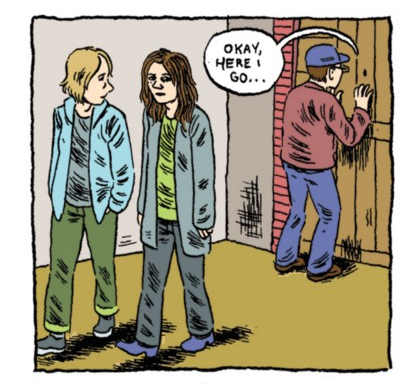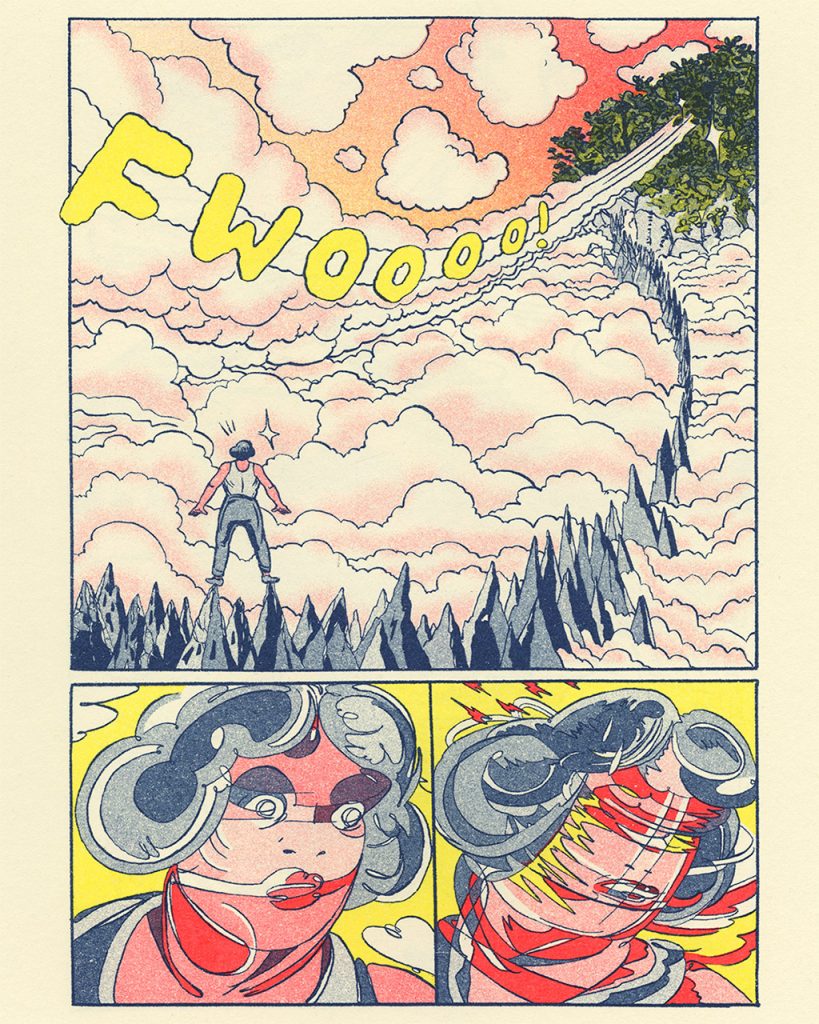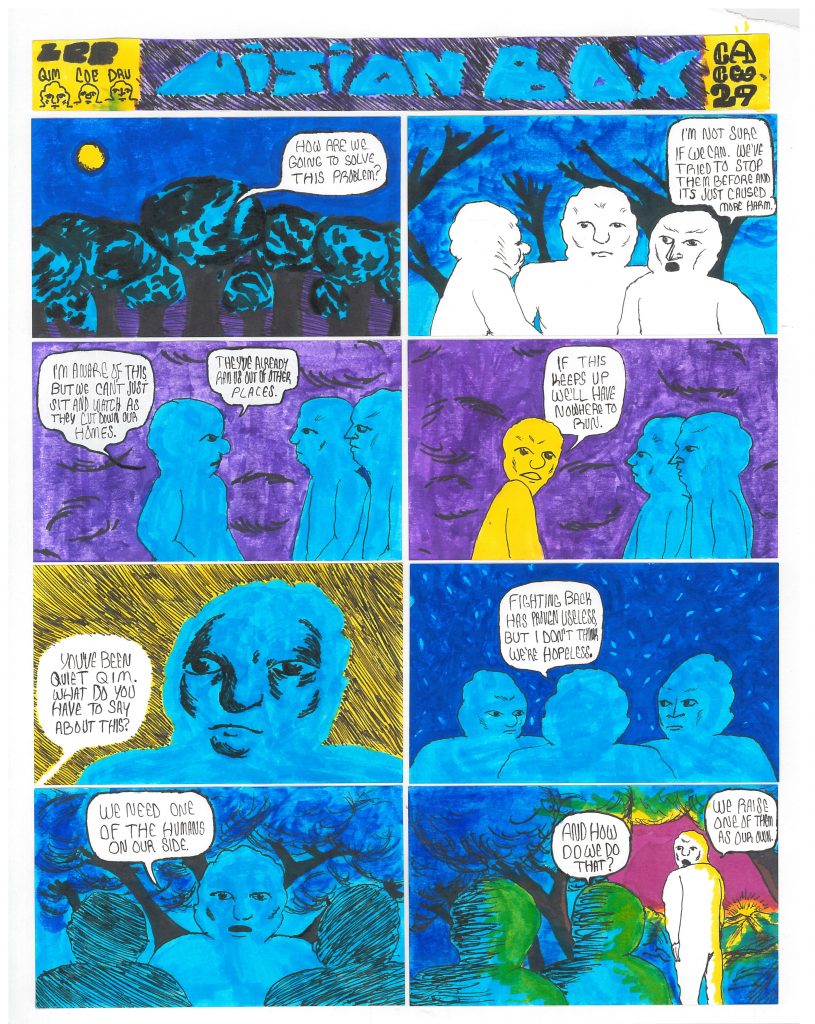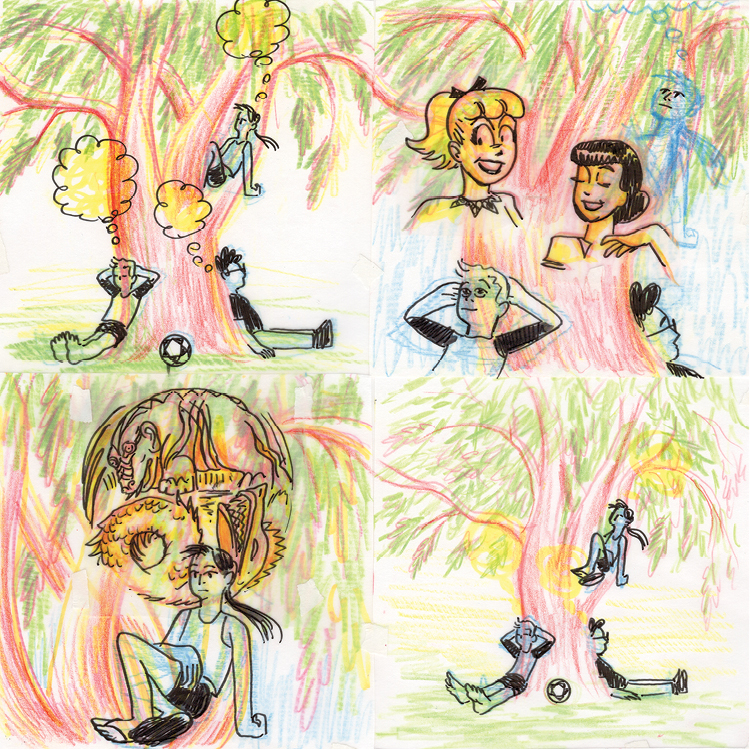Comics WorkbookOctober 5, 2017Festivals and Showsby Adam Griffiths
The first book I purchased on the expo floor at this year’s Cartoon Crossroads Columbus was Kyle Baker’s.
Earlier this year, I had seen Baker speak at the Schomburg Center in New York about his book, Nat Turner to a roomful of kids. At the time, I had been struck by his ability to communicate; his engagement with the audience seemed intrinsically connected to his unabashed and explicitly mercantile use of language. Odd, how this seemed to captivate both his panel members and the audience, young and old.
The persona of the salesman is an American motif – a motif that, under our current political climate, is being reduced to prideless status by the huckster in the Oval Office. When exactly did Americans need to believe that a good businessman’s success is dependent upon rhetorical violence and winner-take-all bullishness? I chose the term ‘A Comics Id is Tenderness’ for this write-up because Baker’s work revisited me several times during this expo. Over the course of the week, it became more and more clear to me that Baker has been a creator who has deftly championed the stories he feels are important to him alongside of his commercial work, who has kindly informed peers of his intentions, who brushes from shoulder the allegedly unforgivable concept of sacrificing creativity for financial gain.
More on this later. To the lectures!
(Editor: What follows are Adam’s notes and thoughts on the lectures and talks he attended in the two days of CXC programming held on the OSU campus (9-28/9-29), and the two days of the CXC expo which was held at the Columbus Metropolitan Library (9-30/10-1.)
—————————————————————————————————
Dan Gearino on Research Methodology Applied to Comics-Making History
(Thursday, Sept. 28th 2017, at the Billy Ireland Cartoon Library & Museum)
Dan Gearino on Phil Seuling: Phil Seuling is regarded as a pioneer of comics fandom during the late 60’s and early 70’s – first when serving as organizer of the annual New York Comic Art Convention and then with his Sea Gate Distributors Company, which laid the groundwork for the direct market system of distributing comics.
Did Seuling’s arrest on March 11th, 1973 lead to the creation of the direct market as we know it today? Seemed so, but when Gearino went investigating, he found that the arrest, for ‘distribution of obscene material’, was nowhere near as simple as he thought. While fellow early comics distributors and champions of comics such as Jim Hanley sincerely believed that Seuling’s aggravation with censors was the spark for his history-making wholesale business venture, Seuling’s former business partner Jonnie Luvas could vouch for Seuling’s motivations more clearly.
The tricky part here was that Luvas, less a comics fan and more a business ingenue, had moved on from comics. To find this person who could truly vouch for Seuling’s acumen in business, Gearino had to ‘go outside of existing source records,’ and penetrate several outlying personal networks of non-comics lovers. Luvas (yes, Johnny Thunder is named for her) was a key figure in Seuling’s business life who understood that Seuling was actually seeking to escape his passionless teaching gigs.
The importance and meaning of this investigation has to do with progressive incarnations of the comics business. Before the direct market, Gearino explains, comics were sold indiscriminately as mass market objects; this was how comics ended up as a part of mainstream culture. You could find them anywhere – on newsstands, in grocery stores, dime shops. By the late sixties, however, this business model was crumbling, and store owners were clearing gluts of low-cost, low-selling comics from their retail spaces.
Seuling’s creation of the direct market paved the way for the comics specialty shops of the 1970’s and 80’s. These specialty shops saved comics as we know them, as they could not only sell new comics being made, but also the comics of yesteryear. Comics hoarding found its reward in this new market. Back issues and loyal accumulations of forgotten works could be pulled out of obscurity.
—————————————————————————————————
Billy Ireland Cartoon Library and Museum Highlights
Tales from the Vault: 40 Years / 40 Stories, curated by Jenny Robb and Caitlin McGurk
Comics history is both creativity and industry, here illustrated by selections of original works and artifacts.
“Creepy” was the first word that came to mind when regarding this bathing suit from 1950, scribbled on by cartoonists such as Ernie Bushmiller, Milton Caniff, Alfred Androla, Otto Soglow, Ham Fisher and others. The museum has six of these bathing suits, and they were drawn on by these superstar artists at a promotional party for a waterproof ink pen. Life magazine photographed the party and later, deciding the images were not family-oriented enough, declined to publish them.
Roe v. Wade Comics
Comics has a documented history in its deployment for use in the political arena. Here, we see two causes with inverse agendas using comics as propaganda. You can read either of these comics in full at http://www.ep.tc/junior/
Who Killed Junior? 1973
This comic, published by the organization Right to Life (the largest pro-life organization in the country, now called The National Right to Life), illustrates the abortion procedure from the viewpoint of a destroyed fetus.
Abortion Eve, 1973
By “Chin Lyvley” (Lyn Chevli) and “Joyce Sutton” (Joyce Farmer)
The hazards of promoting abortion in America in any way are evident here in the authors’ use of psuedonyms. The women both worked as birth control counselors at The Free Clinic in Laguna Beach, California. Under the heading of their company, Nanny Goat Productions, they published this comic which provides arguments for the legality of abortion, and also personal accounts from a diverse array of women about their abortion experiences.
I Know! Let’s Drop Taxes Completely and Let Our Kids Worry About ‘Em! 1985
Jim Kammerud for Norfolk Daily Press / Times Herald
—————————————————————————————————
Handwritten Notes from Talk and Teach Presentation: Kevin Huizenga on Depicting Time in Comics Form
(Thursday, Sept. 28th 2017, at the Billy Ireland Cartoon Library & Museum)
—————————————————————————————————
SÕL-CON LUNCH BREAK AND TALK-BACK
Kat Fajardo, Vicko Alvarez, Lisa Sheperd, Jiba Molei Anderson
(Friday, Sept. 29th 2017, in Hal Hall, on the OSU campus)
(Editor: Sol-Con is another comics festival that happens on the OSU campus simultaneously, allowing folks to move seamlessly from CXC events to Sol-Con events, as Adam did here and there. On Sat./Sun. the Sol-Con guests and exhibitors joined the CXC expo at the library.)
“What is your favorite thing about comics?” was one of the questions asked by the large group of children attending SÕL-CON this year, which, in my year of absence had transformed into an intensive of workshops and instructionals on drawing and storytelling for youth. “My favorite thing,” said moderator Frederick Aldama, “is seeing the younger generations take up making comics.”
A real standout during this talk was Chicago-based Tejana Vicko Alvarez, who couldn’t stress enough that the kids present recognize that their taking part in SÕL-CON probably meant that each and every kid there was interested in a life pursuit doing what they loved. “I tried to find a career and got bored of it real quick,” she says, and then admits, “the one thing I enjoyed I was told not to do. It was smartest decision I ever made to come back to art.” She continued, it helps that “I had a really pushy friend,” who encouraged her to follow her calling in comics.
“How many of y’all have heard that art is gonna make you money?” Vicko asked the audience. All of the kids raised their hands. “How many of you like art?” All hands raised. At this point, Jiba Molei Anderson, who was watching the talk, joined the panelists onstage. “If I ignore something I love, my mental focus is gonna go out of whack, right?” Alvarez declared. The children agreed with her.
“We are all here for the love,” Anderson says. “Even when we’re frustrated we’re not gonna quit. Creative people, to survive we really need to create…that hamster wheel never shuts down.”
“But tethering that to real life is always a challenge to me,” said Lisa Sheperd.
Lisa Sheperd talked about how doing this expo was moving her back towards comics. “Seeing that spark in you guys’ eyes reminded me of the spark I once had . That’s a great thing that doesn’t happen everyday! I’m putting my work out again because SÕL-CON encouraged me… Don’t let it slide by and let life get in the way.”
More Quotes from SÕL-CON Panel
“What don’t you like about comics?” was a question from a boy who remained behind with his mother after the other children left for workshops.
– “I don’t like posers in art trying to tell me how to create,” said Jiba.
-“I don’t like what I see when people not from my community try to tell my story,” Vicko Alvarez said.“What do you see when you see Latinas in the media?” she asked the audience. “Sexy hot mammas!” A woman called out. “Most Latina women look like my mom,” Alvarez continued, and “if you don’t tell your story, somebody else will, and they’ll base it off of stereotype.”
-“Mainstream comics look to what we’re doing right here, right now. The problem is, there are not enough people of color working at DC at Marvel,” Jiba Andersen says. “the people here in this room today? Creators of color? We make our own. We do it this way because you have a community that has felt so maligned for so long… They see what we’ve been doing, we’re here and we’ve been here. The problem is that the push-back can’t be handled. They know that we can talk to people who cannot listen through our art.”
-Vicko: ” …people put out tragedy porn and that’s not changing a thing.”
—————————————————————————————————
Spotlight on Chris Ware
(Friday, Sept. 29th 2017, at the Wexner Center, on the OSU campus)
A near religious silence had fallen over everyone walking out of the Chris Ware dialogue at the Wexner Center. A masterful storyteller and illustrator, Ware’s talents have been visibly leading the illustration world, in the name of comics, for some time now. His discussion with Caitlin McGurk signaled that he remains unrelenting.
As I was listening I realized that Chris Ware’s humorous import is indeed a formula, but that he definitely showed up at this discussion, and probably shows up at every discussion, trying to give away that formula, which is great. Any artist worth her/his salt is always acting within a spirit of generosity. Perhaps Ware is so incurably sad because of how bad he himself believes he is at communicating; a suitable contradiction for a person who has donated their life to creating works of art.
The Chris Ware formula (or, American humor in a nutshell)
1) Declarative sentence.
2) Rebuttal of declaration (typically more complex and cruel than it needs to be, so, funny.)
3) Agreement with his own previous rebuttal finally, because self-rejection is an un-frightening, redundant horror that should make you smile warmly.
So then what Ware does is he puts the formula to work. The guise here begins with Ware saying:
1) “Comics are an art of memory.”
2) But then, because everyone in the room including Ware is, y’know, kind of old, we then have to have a discussion about how terrible we all are at remembering things. Of course we have to bring this up, because in order to remember what we were just (just!) speaking about, we have to introduce dissonance tension to our brains through aural communication with other humans. We are becoming ridiculously complex here in the service of Ware’s humor:
“When you become a cartoonist, you begin to lose track of your language.”
We as an audience, are becoming redundant in order to allow Ware to mirror the brain’s experience of memory for us. Where did Ware get the concept of “comics as an art of memory?” Why in fact, Ware states, rather meekly, he got it from a paper that his stagemate, Caitlin McGurk wrote!
The room warms to Ware as the surprised McGurk, suddenly joyful, becomes flustered and confused, flushed and slightly embarrassed. Ware has delivered his sweet, sweet punchline. It’s almost too saccharine, nearly syrupy!
3) The agreement that Ware has set us up for here is that we’ve been having a discussion about McGurk, not Ware, since we began, and that we will now remember, “Comics are an art of memory,” in all its redundant, charitable, pitiable human glory. Too clean!
—————————————————————————————————
—————————————————————————————————
CXC Award ceremony
(Friday, Sept. 29th 2017, at the Billy Ireland Cartoon Library & Museum)
(Editor: Kyle Baker was awarded the CXC Master Cartoonist Award, and Howard Cruse won the CXC Transformative Work award.)
Revelations from the award ceremony:
Tom Spurgeon praises Kyle Baker as a “Leticious learner.”
After thanking Howard Cruse for his “Masterful work,” Tom Spurgeon asks Cruse to think about getting Stuck Rubber Baby back into print. ‘Oh my goodness, it is a shit-ton of work to re-release a treasured, nearly forgotten book,’ I scribbled. Then it dawned on me: Stuck Rubber Baby isn’t merely a political story about the Civil Rights Movement. It’s a teen mood sugar fiction that affects a whole country.”
—————————————————————————————————
The Other Mainstream: Indy Creators on Non-Indy Books
Jeff Smith, Peter Bagge, Kyle Baker, and Connor Willumsen
(Saturday, Sept. 30th 2017, at the Columbus Metropolitan Library)
In this dialogue, we are revisiting Kyle Baker again. What’s unfortunate in this particular discussion is that there is no visible female contribution. However, what ended up happening was that Kyle Baker – long known for his trademark crankiness – opened up to the audience in a way that is (apologies, meme) unexpected.
Peter Bagge: “Spiderman (Bagge’s creation → Spider-Man, Startling Stories: The Megalomaniacal Spider-Man – a reinterpretation of the SP origin story) was the best-selling comic I had ever made and the worst-selling Spiderman Comic ever.”
Kyle Baker laughs at Peter Bagge’s comment, then goes on to say: Robert Morales, when developing the script for the series “Captain America: Truth,” has used the term ‘drugs’ throughout the entire story. The story details a fictional declassified experiment in which African Americans are the precursor experiment to the secret project that creates Captain America. “We gave the manuscript and art to the publishers and they loved it, but they wanted to replace the term ‘drugs’ with ‘serum,’ so essentially the term “drugs” in Morales’ story came to stand less for something like the Tuskegee experiment and more for the alleged HIV conspiracy.”
Baker then described how he revisited some of these themes from this book in Leticia Lerner, Superman’s Babysitter, a short comic he completed in 1999 for the DC Elseworlds 80-Page Giant #1.
I’m going to revisit Kyle Baker’s work again at length here, to describe, I guess, what sort of happens with modern commercial illustrators in regards to their relationship with their employers. Baker is willingly immersed in comics mythology – it has replaced any previous myths imbued in him in concern to civilization – everything from religion to gender. Somehow, this deep engagement has made him an indispensable employee within a mainstream corporate media outlet. It may seem that Baker retains a sort of power through publishing these stories that are really important to him and to his progression as a drawer. However, the full picture we don’t get from Baker when he is telling us about these industrial anomalies – these stories he most cares about – is that he’s also completing an insane amount of commissioned work as he gets the access to publish these stories that mean the most to him.
To end here, I want to include some quotes by Connor Willumsen, a fresh cartoonist whose work I think represents the next wave of comics, which is COMICS LITERATURE.
“You can never predict what people are gonna respect or not.”
“With Witchlands, I tried to do it like uh, how these comics are invented?”
“I always found out about these rules the hard way.”
What was so calming about when Connor spoke of his experience in mainstream comics contemporaneously was that the industry-men sitting next to him quivered at hearing of Connor’s creative travails. Connor’s a young man, no children to take care of, no family to support; his focus remains on the mythology and drawing practice, not on salary. What luxury had those seasoned professionals grown to actually? Who cares? It was nice to see those older industry men loosen up – they all asked Connor if they could take a look at his books later. I don’t know who planned this discussion, or if anyone could foresee that this type of generational showdown might occur, but we were there to witness it.
—————————————————————————————————
Howard Cruse, Emil Ferris, Mimi Pond, Derf Backderf: Quotes from Comic Memoir Discussion
(Saturday, Sept. 30th 2017, at the Columbus Metropolitan Library)
Below are a few quotes from this discussion, in which Emil Ferris, creator of My Favorite Things is Monsters, comes to the realization that these comics people are in fact, her people.
“You can’t be afraid to make yourself look like an asshole” -Derf Backderf
“That guy who wrote Stuck Rubber Baby is a different guy than who I am today. The guy who wrote that book exists within the soft glow of goodwill.” -Howard Cruse
“I could see the danger of getting stuck in a place like that.” – Mimi Pond, on writing about being a waitress in Over Easy and The Customer is Always Wrong.
“Fine art was a pile of bricks accompanied by a long explanation… I finally came to the fact that this story was going to be a graphic novel.” – Mimi Pond
“When I first encountered Lynda Barry,’s work, I recognized an artist who goes to a place in her head that I’ve seen before in my own head.” – Emil Ferris
A question that came up was:
‘Is the persistence of memoir comics a novelty of identity politics these days?’
“All those labels are out the window. If it’s good comics, we want it.”
-Derf Backderf
—————————————————————————————————
Quotes from SÕL-CON Panel Three: Creators of Color & Industry
Moderated by Crystal Gonzalez, J.M Hunter, Carlos Perez, Albert Morales, Andres Vera, and Verzelle James
(Sunday, Oct. 1st 2017, at the Columbus Metropolitan Library)
“You have to be proactive about finding your market.”
“They ask for diversity, and then they say,’uh, it’s a little too diverse.” – Carlos Perez
“Respect is key. If you write a story without research, it’s all that you don’t know that gets left out.” -Michael Bendis, cited.
When I saw Verzelle James’ comics earlier in the week at SOL-CON, I knew I had to have them. They were/are the best of what comics has to offer – symbology applied, in varied textures of ink, to the surface of a perfectly managed black and white newsprint surface. Seeing his work and getting to speak with him was like diving into a longbox, finding a floppy comic you like, and as you flip through it, the author sidles up and says, “Want me to sign that?”
Only eight pages of comics here from 1991.
James only had about four comics to sell, some reprints of pin-ups, and all of them were over a decade old. These were his passion projects. During this panel, James discussed how much commercial illustration work he had done. I realized, looking over his books, that whatever had happened to spur these floppies into being was something that he wished to revisit. How had he gotten this work into this conference? How do works of such creative fervor flame up again and manage to find their way into the eye-range of another creator? After the panel, James asked me how I felt about the discussion. “Insight from people in the industry is priceless,” I said. He didn’t seem to have a problem with that answer.
Reasonably though, what does success really look like for people of color in the comics industry? I could bring up a few artists, one or two writers, sure! But progress, in and of itself, can masquerade too.
I think that if Cartoon Crossroad Columbus is to continue upping the stakes for gender, age, and race inclusivity in comics, then something must be done about the SÕL-CON/CXC partnership. This year, the connection between the events became ever more evident, with Caitlin McGurk and Jenny Robb doing as much equal time as they could between both conferences, and SÕL-CON participants being flagrantly present at CXC events. The best innovation is how exhibitors from both cons are mixed in together during the expo and lectures that take place at the library during the weekend. This year, SÕL-CON took the step of educating youth about drawing, and CXC took the step of giving Kat Fajardo the emerging talent award. The first year of this conference, I remember running from one side of campus to another in order to get the most out of both cons. This year, I definitely did not have to do as much running, but I’m wondering if the Billy Ireland Cartoon Library and Museum couldn’t stand to create some dedicated programming to incubate talent outside of the OSU student body that will engage at a community and studio capacity with their collection and resources.
—————————————————————————————————
Emil Ferris Spotlight
(Sunday, Oct. 1st 2017, at the Columbus Metropolitan Library)
First, if you don’t know about Emil Ferris’ My Favorite Things is Monsters, read this article so I don’t have to re-explain the miracle that this book is.
Second, I have never read My Favorite Thing is Monsters. It was a book that came out to much acclaim this year, and it wasn’t until I saw Ferris herself, and most significantly, heard her speak that I now feel the impulse to go and get the book.
It took Emil Ferris six years to write My Favorite Thing is Monsters. What sold me about the book is what Ferris means by Chicago. “The west is nothing like everywhere else in the world. Everywhere else, the wealth you have is in the older people in your life,” she says.
Ferris means ‘old’ Chicago. In her own words, Ferris states that ‘there were all of these older actors and actresses from the silent film era, Georgette Leblanc types who were living alongside survivors of the Holocaust. It was a deeply haunted population…I realized I had access to all of these stories.”
“As I was drawing forth my smaller self , love kept being the thing that kept me going…I realized that I wanted my kid to see me kick some ass, and we have to give our daughters badassery.”
“The line creates secret unknown things to people from the heart of the creator.”
“I began to see that each page I did had a taste. One page had a taste of rosemary and mint. Another tasted of syphillis, though I have never had syphillis…that’s what synthesia does.”
—————————————————————————————————
Going to close on Kyle Baker’s work. The best reason to visit a conference like Cartoon Crossroads Columbus is that you get encounters with current and historical works about modern life that aren’t going to be seen elsewhere, all in one room. There is a cornucopia of independent comics creators from all walks of life here and let’s face it: The fine art world doesn’t accommodate unknown milestone creations from the world of comics, and the mainstream world of comics doesn’t accommodate emergent comics that might be unquantifiable within the canon of superbabes, superheroes, blood, guts, and uberships. It’s an in-between world where the sentiment of western middle-class expression is never treated condescendingly as ankle-browed nostalgia or visual brik-a-brak – a place where a commercial illustrator like Baker can let loose creatively, outside of his industrial obligations and have an audience, where an unconventional illustrator like Mimi Pond can fictionalize her own biography as a waitress without interpretational friction – a place where an established editorial cartoonist like Signe Wilkenson can introduce a new audience to her work within the appropriate context of its historical footnotes.
It’s intellectual even when it’s pretending to be dumb. It’s philosophical even when it’s aping the pleasures of brain-vacancy. It’s irreverent without portending the inherent complacency of ‘fine.’
It’s comics, and it is the most central American art.
—————————————————————————————————
Adam Griffiths is a comics artist from Takoma Park, MD. Catch his ongoing comic – American CRYO – HERE.
Share this page: [...]






